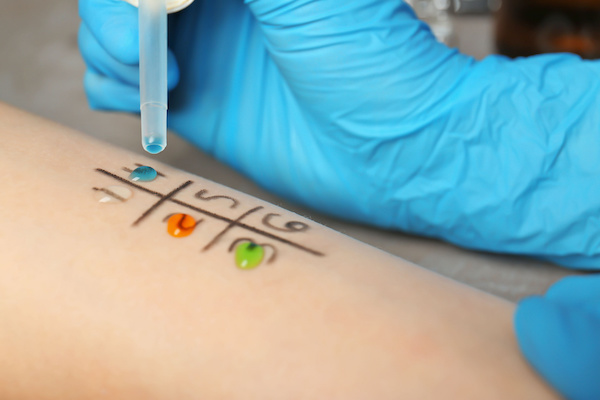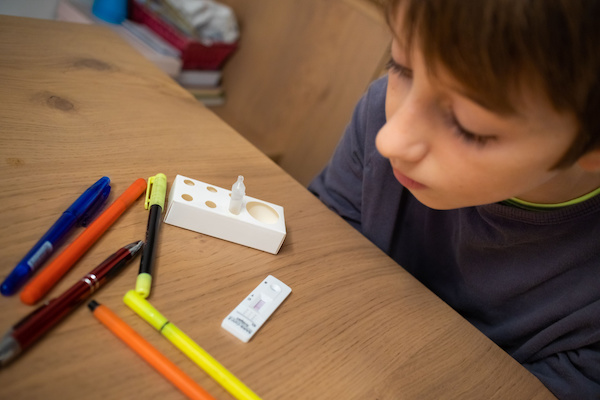November Is Diabetes Awareness Month: Watch Out for Signs of Neuropathy
- Details
- Written by Dr. Michelle Castiello, Podiatry
- Category: Health
 Diabetic neuropathy is a type of nerve damage that causes pain and numbness in the hands, legs and feet of diabetics; in fact, diabetic neuropathy is estimated to affect as many as 50% of people with the disease.
Diabetic neuropathy is a type of nerve damage that causes pain and numbness in the hands, legs and feet of diabetics; in fact, diabetic neuropathy is estimated to affect as many as 50% of people with the disease.
Anyone with diabetes can develop nerve damage – which typically can occur within the first 10 years of a diagnosis – but certain factors increase your risk. Those include high blood sugar levels; being overweight; and having high blood pressure and/or cholesterol.
Symptoms of peripheral neuropathy – the type of diabetic neuropathy that affects the legs and feet – include:
• Numbness or reduced ability to feel pain or temperature changes
• Tingling or burning feeling
• Sharp pains or cramps
• Muscle weakness
• Extreme sensitivity to touch
• Serious foot problems, such as ulcers, infections, and bone and joint damage
Nerve damage combined with poor circulation can put you at risk of developing a foot ulcer – the initial event in more than 85% of major amputations that are performed on people with diabetes. Every year in the U.S., about 73,000 amputations of the lower limb not related to trauma are performed on people with diabetes.
If you experience any of these symptoms, don’t wait for your next appointment; see your podiatrist right away:
• Pain in your legs or cramping in your buttocks, thighs, or calves during physical activity
• Tingling, burning, swelling or pain in your feet
• A change in the color, temperature and/or shape of your feet
• Loss of hair on your toes, feet, and lower legs
• Dry, cracked skin on your feet
• Thickened, yellow, or ingrown toenails
• A blister, sore, or ulcer
Tips for maintaining healthy feet – for diabetics and non-diabetics both – can be found here.
Make sure to check your feet every day so that you can catch problems early and get them treated. Routine foot exams and early treatment greatly reduces your risk of amputation. Dr. Michelle Castiello is a podiatrist at White Plains Hospital Physician Associates, seeing patients at 600 Mamaroneck Avenue, Suite 102 in Harrison. To make an appointment, call 914-723-8100.
Dr. Michelle Castiello is a podiatrist at White Plains Hospital Physician Associates, seeing patients at 600 Mamaroneck Avenue, Suite 102 in Harrison. To make an appointment, call 914-723-8100.
Solving That Itch with a Scratch Test
- Details
- Written by Joanne Wallenstein
- Category: Health
 The simple procedure, followed by a series of injections, can bring much-needed help to seasonal allergy sufferers.
The simple procedure, followed by a series of injections, can bring much-needed help to seasonal allergy sufferers.
The American College of Allergy, Asthma and Immunology estimates that more than 50 million people in the U.S. experience some type of allergic reaction each year. In many cases, those people frequently endure congestion, itchy eyes, a scratchy throat, and sinus-re¬lated issues. Adding to those frustrations may be the fact that they’re not even sure what they’re allergic to.
But answers, and relief, can be readily available through a scratch test, or prick test, to identify allergy triggers. The procedure, which is available onsite at Scarsdale Medical Group offices, involves a simple series of steps:
• The patient’s back or forearm is cleaned, after which a series of marks – typically around 60 – are made on it.
• A liquid extract is applied to each mark. The extracts contain proteins isolated from allergens such as ragweed, grasses, animal dander, dust mites, and mold.
• Using a needle, each mark is gently scratched to introduce the extract under the skin.
• After a brief wait, the marks are examined to see which ones develop a bump approximately the size of a mosquito bite, known as a “wheal,” with a corresponding red area, known as a “flare.”
• Using a ruler, each wheal is measured to see if any is longer than 4 millimeters – the length that indicates an allergic reaction.
All told, the entire procedure takes about 15 minutes. If the scratch test shows significant allergic reactions, a course of allergy shots is often the best treatment in providing significant relief.
Patients receive injections that contain a mixture of tiny amounts of their allergens. The shots are formulated at levels that stim¬ulate the immune system but do not cause a full-scale allergic reaction. With each visit, the patient is injected with higher concentrations of the allergens.
The allergy shots become effective very quickly. Within two weeks or so, many patients will feel relief from achy sinuses, postnasal drip, and itchy eyes. At about six months into the process, patients will be able to tolerate allergy shots in clinically effective strengths. The next step is to get maintenance injections weekly, eventually reducing their frequency to monthly.
Allergy skin testing can be done for all age groups to identify potential allergens. Indoor sensitization (dust and animal dander) can begin between six months and two years, while pollen sensitization develops between two and seven years old.
Knowing what you are allergic to can help you avoid those substance(s) in the future. And it’s not always a matter of merely solving recurring cases of the sniffles. Allergic conditions are one of the most common health issues affecting children in the U.S., and it is estimated that a severe allergic reaction (anaphylaxis) to food  generates 90,000 emergency room visits a year. Allergies are also the sixth leading cause of chronic illness in the U.S.
generates 90,000 emergency room visits a year. Allergies are also the sixth leading cause of chronic illness in the U.S.
Understanding what to avoid – and taking a 15-minute test to reach those conclusions – is, to coin a phrase, nothing to sneeze at.
Dr. Kirk Sperber is an allergist and immunologist at Scarsdale Medical Group in Harrison. or an appointment, call 914-723-8100.
When “Up Your Nose” Is to Be Taken Literally
- Details
- Written by Dr. Clare Dean, Otolaryngology
- Category: Health
 “Up your nose with a rubber hose” became something of a catchphrase in the 1970s, thanks to its recurring use as an insult on the sitcom Welcome Back, Kotter. While we don’t see rubber hoses stuck up children’s noses, there are several fairly common objects that can be removed relatively easily – and some that can represent a serious risk.
“Up your nose with a rubber hose” became something of a catchphrase in the 1970s, thanks to its recurring use as an insult on the sitcom Welcome Back, Kotter. While we don’t see rubber hoses stuck up children’s noses, there are several fairly common objects that can be removed relatively easily – and some that can represent a serious risk.
I categorize such objects into three groups: organic, inorganic, and button batteries. While the last – so named for their button-like size and shape – are of course inorganic, they can pose a real danger to a child’s health. Such batteries can essentially create a negative ionic field around them, a very alkaline environment. Not only can it be painful – imagine having bleach in your nose, ear or mouth – it can also cause actual burning inside the nose, resulting in tissue necrosis (death) and potentially burning a hole in one’s septum.
For those reasons, such a case is a medical emergency. And it is a time-sensitive situation, as significant damage can occur within a couple of hours.
A parent can try to dislodge the button battery with a strong magnet, which may suck it right out of the nasal passage. (When I was a resident, I had a magnet connected to my I.D. badge for exactly such circumstances.)
If someone has a button battery stuck in their nose during the daytime, I recommend promptly calling an ENT’s office, who will clear their schedule to remove the object. After hours, you should go immediately to an emergency department. To avoid a long waiting time, make sure you tell the admitting staff member that your child has a button battery in his nose and that you need to see a doctor right away.
Happily, my other two categories are usually not as traumatic or time sensitive. While an object stuck in the nasal cavity can theoretically be sucked down into the windpipe, aspiration is an uncommon occurrence. I compare having either organic or inorganic objects nasally stranded to suffering a knee scrape – unpleasant, perhaps, but quickly healed.
Organic objects tend to have more complications because they are more likely to cause infection and change within the nasal environment. If a child has pushed a piece of food – a peanut is a popular choice – into their nasal cavity, its interaction with the mucus membrane can turn it mushy and harder to remove over time. I usually recommend getting organic objects removed within hours of the incident.
Inorganic items like coins, Legos, crayons and beads can be addressed within a day or two. Their tissue damage (excluding button batteries) is limited to scrapes or local swelling and is less likely to cause long-term, or even short-term, infection.
To remove such objects, we can use a number of tools, including a specialized kind of tweezers and even little hooks; when used at the correct angle, we can get right into the hole of a bead and pull it out, or go behind the object and effectively push it out. Because of the need for these specialized tools, an ENT visit is preferred over an ER visit. However, if the child is responsive and able to follow directions, the parent can ask them to inhale through their mouth and then exhale through their nose; this approach frequently forces the object out.
I’d lay out the timeline for seeking help as:
• Button battery – drop everything and go to the ER immediately
• Organic substances – finish what you’re doing and go within a few hours
• Inorganic objects (excluding the button battery) – you can potentially wait longer to make it to an ENT office
Even though I’m a physician, the worst thing to deal with is a bug. They are actually very common, but never something you want to see! Dr. Clare Dean is an otolaryngologist at White Plains Hospital Medical & Wellness in Armonk and at Scarsdale Medical Group in Harrison. For an appointment, call 914-849-3755.
Dr. Clare Dean is an otolaryngologist at White Plains Hospital Medical & Wellness in Armonk and at Scarsdale Medical Group in Harrison. For an appointment, call 914-849-3755.
Million Meal Project Launches to Address Global Food Insecurity
- Details
- Written by Joanne Wallenstein
- Category: Health
 The Blumberg family of Edgemont is launching the Million Meal Project with a goal of packaging and distributing 1,000,000 meals to families in need all over the world by 2028. The organization will partner with global nonprofit Rise Against Hunger and other local organizations to host monthly meal packaging events in the Edgemont community over the next five years. The first event will be held on Saturday, November 19 at Greenville Elementary School.
The Blumberg family of Edgemont is launching the Million Meal Project with a goal of packaging and distributing 1,000,000 meals to families in need all over the world by 2028. The organization will partner with global nonprofit Rise Against Hunger and other local organizations to host monthly meal packaging events in the Edgemont community over the next five years. The first event will be held on Saturday, November 19 at Greenville Elementary School.
“Our family volunteered earlier in the year for a Rise Against Hunger event hosted by the Edgemont Community Council at Seely Place Elementary School and was inspired,” said Casey Blumberg, Wilson Blumberg, and Elyse Blumberg, co-founders of the Million Meal Project. “We had a lot of fun with friends at the event and were impressed with how easy it was to volunteer our time and make such a difference in so many lives.”
"The Million Meal Project's goal to package one million meals over the next five years will be incredibly impactful for the people Rise Against Hunger serves around the world. Our work to end hunger starts with a meal because, for those facing hunger, a meal can provide needed nutrition and support education, health and opportunities for bright futures," said Richard Kearney, Interim CEO of Rise Against Hunger.
The Million Meal Project welcomes any local organizations and families to participate by co-hosting events throughout the year or joining for larger events. The organization will also be donating $0.38 per meal packaged. Donations are welcome at any of the meal packaging events as well as on the Million Meal Project’s website.
To volunteer or donate at the Million Meal Project’s launch event on November 19, please click here. For more information, contact Matt Blumberg at info@millionmealproject.org.
Fire Fair at Crossway on Saturday
- Details
- Written by Joanne Wallenstein
- Category: Health
 The Scarsdale Fire Department is teaming up with the National Fire Protection Association to celebrate the 100th anniversary of Fire Prevention Week with their annual Fire Prevention Fair. The event will be held at Fire Station 3, 56 Crossway, on Saturday, October 22, from 10:00 AM to 2:00 PM, rain or shine!
The Scarsdale Fire Department is teaming up with the National Fire Protection Association to celebrate the 100th anniversary of Fire Prevention Week with their annual Fire Prevention Fair. The event will be held at Fire Station 3, 56 Crossway, on Saturday, October 22, from 10:00 AM to 2:00 PM, rain or shine!
Live fire demonstrations will illustrate the dangers of unattended cooking and improper fire extinguishment. There will be antique and modern fire apparatus on display, interactive lessons from the fire-safety trailer, bounce houses, refreshments, and a firefighter read-aloud to guarantee fun for the whole family. Guests are also encouraged to bring their own fire extinguishers from home for a complimentary inspection and hands-on training.
The Fire Prevention Fair is a great opportunity to meet our career and volunteer firefighters, who are eager to share key messages from this year’s campaign, Fire won’t wait.
Plan your escape:
• Make sure your home escape plan meets the needs of all your family members, including those with sensory or physical disabilities.
• Smoke alarms should be installed inside every sleeping room, outside each separate sleeping area, and on every level of your home. Smoke alarms should be interconnected so when one sounds, they all sound.
• Know at least two ways out of every room, if possible. Make sure all doors and windows open easily.
• Have an outside meeting place for everyone at a safe distance from your home.
• Practice your home fire drill at least twice a year with everyone in the household, including guests. Practice at least once during the day and once at night.
For more information, please contact the Scarsdale Fire Department at 914-722-1215.














